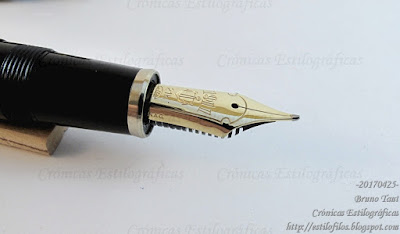Nowadays, anniversary pens are ubiquitous—they make a perfect excuse to create some limited editions and to trigger some artificial demand for some brand. But when did these anniversary pens make to the market? In Japan, the case of the Sailor Jubilee pen at the time of the 50th anniversary of the brand (1962) is well known, and this pen truly deserves its own text. Today, though, we will speak of a previous example, albeit somehow mysterious.
In 1958, the brand Pilot became 40 years old. At the time, the workhorse of the brand was the Super model, which came in a number of versions and sizes, from the Super 50 to the Super 500. And a Super 200 was released for the occasion. But there was nothing special on this particular model save an engraving on the barrel: “40th anniversary of Pilot Corporation”.

The one and only reference to the special occasion. The engraving reads something along the lines of "40th anniversary of Pilot Corporation". Only for shareholders.
However, what makes this pen most interesting is the fact that it was never intended for sale. This anniversary pen was made for the shareholders of the company and for some selected salesmen. And the paradox is that this feature might make this pen all the more valuable, albeit Pilot might not directly benefit from it.

The filling system is the traditional on most Super pens--the hose system, also known and the quarter-switch system.
In fact, a number of commemorative goods were made by Pilot in those years. They were not for sale and, needless to say, there are some memorabilia collectors looking and fighting for them.
My thanks to Mr. NK and to Mr. Shimizu.
Clavijo Velasco Ro-iro – Pilot Iroshizuku Yama-budo
Bruno Taut
Nakano, May 31st 2017
Etiquetas: Pilot
Bruno Taut
Nakano, May 31st 2017
Etiquetas: Pilot















































